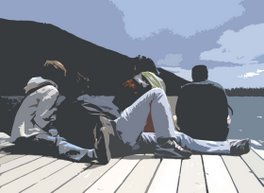
Hello everybody.
Chicago has been playing a key role in the history of music in the last hundred years: the swing, the Chicago blues, the big bands, ballrooms... Unfortunately, not many of the places were this revolution took place are still there.
The district where the black musicians lived once around 1920, Bronzeville, was once a metropolis for emigrants from the south, full of jazz clubs and dance halls. Today, the district is still very depressed and poor, most of the emblematic buildings were demolished, being the paintings in the drive thru of a McDonalds in 35th street the only evidence that once there the history of music was written.
The tour in Bronzeville started in the Lincoln Gardens, the place where King Oliver and his band was in residence, when Louis Armstrong, a young musician from New Orleans arrived in the city. The legend says he asked the cab driver for King Olivier and the driver knew that the Lincoln gardens was the destination of Armstrong. Armstrong started the first musical revolution, playing at the Lincoln Gardens as a second trumpet.
Nowadays, this corporate building stands in the former location of the Lincoln Gardens. No commemorative plaque or monument is there.
Next stop was the Pekin Inn, first place in Chicago to employ pre-jazz musicians and location where they supposedly investigated new sounds, mixing ragtime with other music. Today, only an apartment building complex is there.
The Dreamland Ballroom, the first dance hall in the city, where the most distingushed musicians played, is an empty lot undergoing construction.
The tour continues turning right into 35th street. This street was once the world center for jazz, but today is a depressed neighborhood, where very little remains from the good times. It is certainly not the street where you feel save driving a fancy car like “Pender” or walking with a camcorder.
A hardware store is in the building where once stood the Sunset café, a ballroom where dancers from everywhere in the city came to listen the best big bands.

The wall in the office still conserves the original paintings, which saved the building from demolition, according to one employee. She kindly opened the office and showed us the painting upon request. She also noticed that people is coming nowadays more than ever asking to see the paintings.
In the front door, a scanned copy of a newspaper picturing the early decoration of the Sunset café is the only sign of the history of the building.
Finally, before leaving Bronzeville, we visited the house that once belonged to Louis Armstrong and his wife Lil Harding, a jazz pianist and band leader, walking distance to the 35th street, where both worked with King Oliver band.

As an ending point of our stay in the Windy City, we visited the Green Mill, the most historic of the jazz clubs in Chicago. The Green Mill opened in 1907, as one of the first clubs in the city, and still remains open today. The Green Mill was the scenario of many mafia related stories and movies, as well as good concerts in his 100 years of non stopping activities.
A venue of modern jazz featuring Chicago musicians (awesome drummer!!!) releasing a new album, followed by a Bebop with a Hammond Chicago band.









